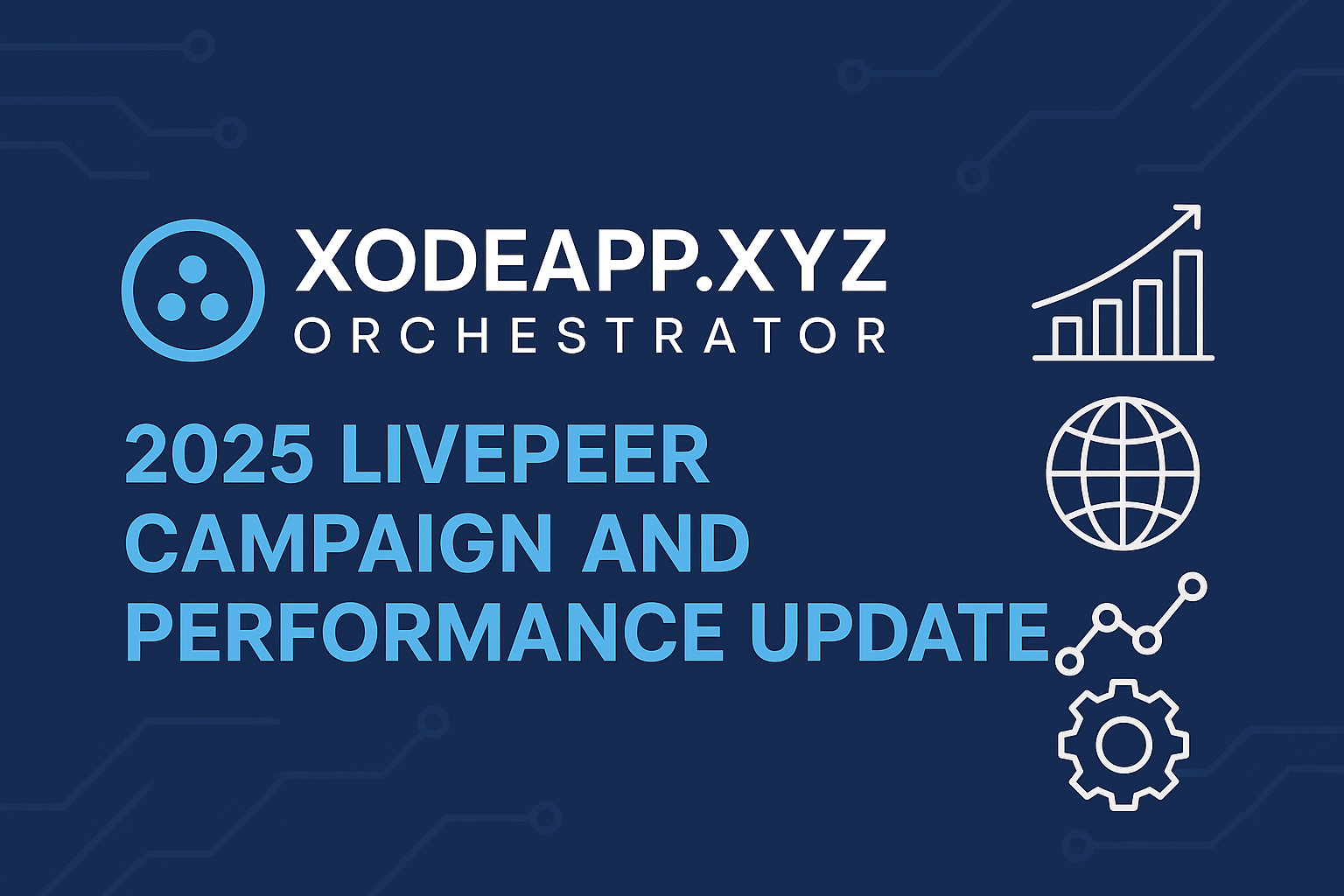Xodeapp.xyz Orchestrator — 2025 Livepeer Campaign and Performance Update
Read the full Livepeer Forum discussion here →
As the operator behind Xodeapp.xyz, I wanted to provide a transparent, technical, and community-focused update following our recent Livepeer Orchestrator Campaign post on the Livepeer Forum.
This post expands on that thread with additional context, performance data, and insight into how we’re optimizing for reliability, GPU efficiency, and decentralization across the Livepeer network.
🧭 Background: What the Forum Campaign Covered
The original campaign thread introduced Xodeapp.xyz as a high-performance, multi-GPU orchestrator contributing to Livepeer’s decentralized video and AI processing network.
We outlined our infrastructure goals, hardware setup, and commitment to transparency:
- Hardware: Dedicated servers with NVIDIA GPUs, RAID1 NVMe storage, and optimized Ubuntu 24.04 environments.
- Software stack: Livepeer node, Prometheus metrics exporter, Grafana dashboards, and custom log ingestion via Loki and Promtail.
- Focus areas:
- Low latency transcoding and AI inference tasks.
- High availability across EU and US regions.
- Consistent GPU utilization monitoring using DCGM and cAdvisor metrics.
The post emphasized our ongoing effort to maintain near-zero downtime and contribute meaningful processing power to the AI and transcoding workloads that power Livepeer’s next generation of decentralized compute.
⚙️ Technical Overview of the Orchestrator Setup
The Xodeapp.xyz Orchestrator is built for stability and transparency. Here’s what goes on behind the scenes:
- GPU Configuration: Multiple NVIDIA RTX cards managed under NVML/DCGM with Prometheus exporters feeding real-time performance metrics.
- Node Monitoring: Loki and Grafana dashboards track GPU temperature, tensor activity, memory load, and transcoding throughput in real time.
- Networking: Cloudflare and Traefik handle SSL and load balancing to ensure smooth peer communication between broadcasters and orchestrators.
- Resilience: Failover policies and automated container restarts (via Docker health checks) help keep the orchestrator live through network events and driver updates.
This system has evolved over several iterations — integrating lessons from hundreds of transcoding and AI inference jobs.
📊 Recent Performance and Metrics
Since launch, Xodeapp.xyz has processed thousands of segments across both video and AI workloads.
Some highlights from recent telemetry:
- Uptime: 99.85% over the last 60 days.
- GPU Utilization: Average 85–92% across active sessions.
- Latency: Average <300 ms per segment.
- Failover Recovery: 100% recovery rate for containerized tasks during scheduled restarts.
- Monitoring Stack: Real-time dashboards available internally, powered by Prometheus, Grafana, and Loki for log and metric correlation.
This consistency ensures broadcasters and AI workloads receive predictable, low-latency performance across our connected GPUs.
🌍 Decentralization and Community Alignment
Our orchestrator is not just about hardware performance — it’s about strengthening the Livepeer network’s reliability and decentralization.
- We participate in ongoing community governance discussions.
- We use open metrics and public transparency reporting.
- We support cross-network collaborations between orchestrators sharing tooling, monitoring insights, and pipeline optimizations.
These align with Livepeer’s broader mission: building a truly decentralized, censorship-resistant infrastructure for video and AI computation.
🔮 Looking Ahead: 2025-2026 Roadmap
The next phase of Xodeapp.xyz will focus on advancing both the technical foundation and the ecosystem value of the Livepeer Network. Our mission is to push the boundaries of decentralized video and AI infrastructure — ensuring scalability, transparency, and measurable real-world impact.
- 🧠 AI workload optimization — Continue improving throughput and efficiency for inference and generative AI tasks, including Stable Diffusion and multimodal models, with a focus on GPU performance, batching, and reliability across regions.
- 🧩 Tooling for Scale — Develop and open-source software that helps orchestrators, broadcasters, and developers scale operations—covering deployment automation, observability, and peer-to-peer coordination within the Livepeer ecosystem.
- 🧾 Open Telemetry & Network Insights — Build decentralized telemetry and metrics aggregation to give the community transparent, verifiable insights into orchestrator uptime, GPU utilization, and network health.
- ⚡ Demand-Driven Market Research — Conduct ongoing research with data-backed feedback loops to identify and unlock new demand channels for Livepeer’s decentralized compute—spanning video, inference, and real-time streaming use cases.
- 💬 Community engagement — Stay deeply engaged in Livepeer governance, forum discussions, and collaborative tooling efforts, ensuring that community feedback directly shapes our technical roadmap.
Our commitment remains clear: continuous innovation, open data, and sustainable growth for a decentralized, AI-driven video infrastructure built on Livepeer.
🔗 Learn More
- 🗨️ Forum post: Livepeer Transcoder Campaign – Xodeapp.xyz
- 🌐 Website: https://xodeapp.xyz
- 🧾 Contact: Reach out via the Livepeer Discord or the Xodeapp contact page.
🚀 Closing Thoughts
Running a Livepeer orchestrator means more than just operating GPUs — it’s about advancing decentralized media infrastructure.
At Xodeapp.xyz, we’re committed to keeping our node performant, reliable, and open, helping Livepeer’s mission to bring affordable, distributed compute to the world.
Authored by Mike Zupper – Operator of Xodeapp.xyz Orchestrator
